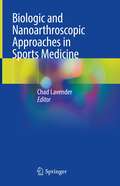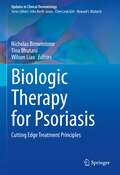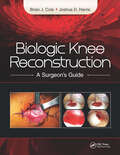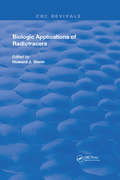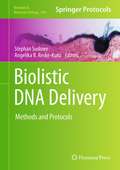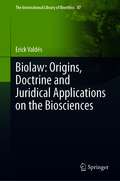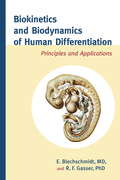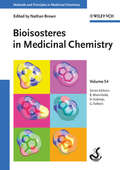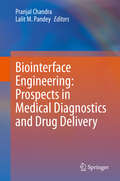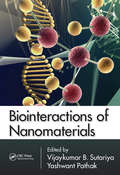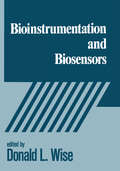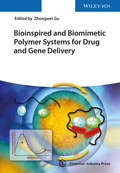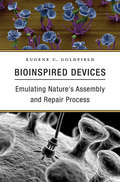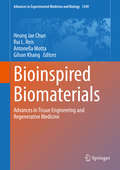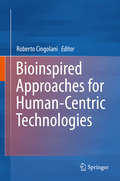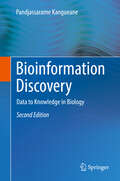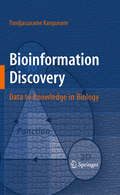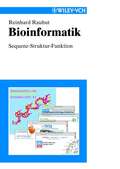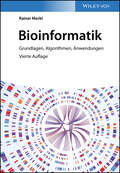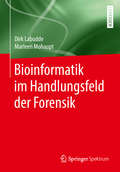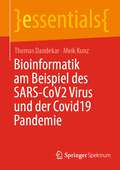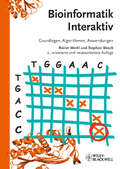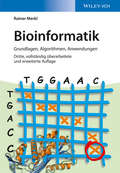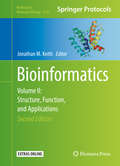- Table View
- List View
Biologic and Nanoarthroscopic Approaches in Sports Medicine
by Chad LavenderIn recent years, there have been a number of exciting advances in biologic and nanoarthroscopic approaches in sports medicine, giving the clinician even more options for safe and effective minimally invasive treatments for the active patient. This practical text presents these breakthrough techniques in detail and describes the authors' experiences and lessons learned.This book is broken into two main sections. The first section presents the history of the use of biologics in sports medicine and will have several chapters describing novel techniques using platelet-rich plasma (PRP) and bone marrow concentrate (BMC), all-inside allograft ACL reconstruction, minimally invasive quad tendon harvest with endoscopic closure, and cartilage transfer (ACT) using an autologous tissue collector, among others. The second section describes the history of arthroscopy and the most recent use of nanoarthroscopy, including several novel techniques utilizing the nanoscope, such as incisionless partial medial meniscectomy, synovectomy of the knee, and single incision approaches for the anterior labrum and rotator cuff.Practical and cutting edge, Biologic and Nanoarthroscopic Approaches in Sports Medicine is an exciting exploration of the most recent management approaches for both sports medicine and orthopedic surgeons.
Biologic Therapy for Psoriasis: Cutting Edge Treatment Principles (Updates in Clinical Dermatology)
by Tina Bhutani Wilson Liao Nicholas BrownstoneBiologic therapy is a treatment that strives to modulate a patient's immune system to fight a given disease. In psoriasis, a skin disorder that is partly caused by a dysregulated immune system resulting in well-demarcated red areas of the skin with white scales, biologic therapy has the potential to vastly improve upon patient outcomes by minimizing the symptoms of this disease while maximizing the safety profile of the therapy. This book offers an up-to-date and comprehensive review on biologic therapy for the treatment of psoriasis. With over 10 FDA approved biologic agents for psoriasis (with more in the pipeline), confusion exists among providers regarding which agent is best for a particular patient. Chapters cover all FDA approved psoriasis biologic agents (including pipeline agents) for use in pediatric, adult, and geriatric patients. This book is unique in that it will not only cover cutting edge treatment principles based on the latest research, it will also be one of the most comprehensive reviews of psoriasis biologics in the COVID-19 era. Biologic Therapy for Psoriasis is a must-have resource for board certified dermatologists and rheumatologists, dermatology and rheumatology residents and fellows, dermatology physician assistants, nurse practitioners and medical students. The ultimate goal of this book is to improve patient care by making the busy practicing dermatology provider more adept with these particular therapies.
Biologic Knee Reconstruction: A Surgeon's Guide
by Joshua Harris Brian ColeTreatment of articular cartilage pathology in the knees of young and active patients is a challenging and controversial issue. Biologic Knee Reconstruction: A Surgeon's Guide is a how-to, step-by-step guide that addresses the evaluation and management of this unique patient population. Internationally renowned cartilage experts Dr. Brian J. Cole and Dr. Joshua D. Harris, along with their contributors, present information on normal and abnormal history and physical examination. The reader will learn proper decision-making using a patient-centered approach of treatment, increasing the likelihood of a successful outcome. In addition to radiographic assessment of articular cartilage, Biologic Knee Reconstruction discusses the use of biomarkers, defect classification, and patient-reported and surgeon-measured outcomes. Aggressive nonsurgical medical management, including medications, injections, physiotherapy, and rehabilitation, is also presented.Biologic Knee Reconstruction also discusses the management of concomitant pathologies such as malalignment, meniscal deficiency, and ligamentous instability. Selection of surgical cartilage restorative treatment options is multifactorial, requiring consideration of several patient-, knee-, and defect-specific issues. All contemporary open and arthroscopic cartilage techniques are presented in detail with high resolution figures. A unique feature of Biologic Knee Reconstruction is the presentation of several chapters discussing non-medical issues highly pertinent to the advancement and future of this field: funding of research and cost of new advanced technologies, regulation of advanced cellular, tissue, and genetic technologies, evidence-based medicine and clinical trial design and conduct, and the ethics of allograft tissues and stem cell use.Features: Technique preference cards from the experts performing cartilage surgery Patient education information The most up-to-date descriptions of advanced cartilage techniques Unique chapters not covered in books elsewhere, including: Biomarkers Patient-reported outcomes assessment Newer injection techniques (PRP, stem cells) One- and two-stage open and arthroscopic techniques using chondrocyte- and stem cell based cell therapies Costs and public and private funding of research Barriers to high-quality randomized trials Governmental regulation and availability/accessibility to patients Gene therapy and tissue engineering Ethics of articular cartilage surgery with stem cells, ex-vivo cell manipulation, and juvenile tissue sources With the most up-to-date content and step-by-step methods for surgical procedures, Biologic Knee Reconstruction: A Surgeon's Guide is the perfect addition to the bookshelf of the orthopedic surgeon, cartilage researcher, sports physical therapist, or athletic trainer who evaluates and manages this unique patient population.
Biologic Applications of Radiotracers (Routledge Revivals)
by Howard J. GlennFirst published in 1982: This present volume presents an excellent amount of animal Models in radiotracer investigations, describes the animal radiopharmacology laboratory, and discusses radiotracer distribution differences between species.
Biolistic DNA Delivery: Methods and Protocols (Methods in Molecular Biology #940)
by Angelika B. Reske-Kunz Stephan SudoweBiolistic transfection represents a direct physical gene transfer approach in which nucleic acids are precipitated on biologically inert high-density microparticles (usually gold or tungsten) and delivered directly through cell walls and/or membranes into the nucleus of target cells by high-velocity acceleration using a ballistic device such as the gene gun. Biolistic DNA Delivery: Methods and Protocols provides a comprehensive collection of detailed protocols intended to provide the definitive practical guide for the novice as well as for the advanced gene transfer expert on how to introduce nucleic acids into eukaryotic cells using the biolistic technique. Split into six convenient sections, this detailed volume covers biolistic gene transfer into plants, nematodes, and mammalian cells, both in vitro and in vivo, as well as the use of gene gun-mediated DNA vaccination in various experimental animal models of human diseases, and the description of biolistic delivery of molecules other than nucleic acids. Written in the highly successful Methods in Molecular BiologyTM series format, chapters include introductions to their respective topics, lists of the necessary materials and reagents, step-by-step, readily reproducible laboratory protocols, and tips on troubleshooting and avoiding known pitfalls. All-inclusive and cutting-edge, Biolistic DNA Delivery: Methods and Protocols brings together the knowledge and the experience of leading experts in the field of gene transfer in order to serve all researchers who wish to further our abilities in this vital field.
Biolaw: Origins, Doctrine and Juridical Applications on the Biosciences (The International Library of Bioethics #87)
by Erick ValdésThis book configures a consistent epistemology of biolaw that distinguishes itself from bioethics and from a mere set of international instruments on the regulation of biomedical practices. Such orthodox intellection has prevented biolaw from being understood as a new branch of law with legally binding force, which has certainly dwindled its epistemological density. Hence, this is a revolutionary book as it seeks to deconstruct the history of biolaw and its oblique epistemologies, which means not accepting perennial axioms, and not seeing paradigms where only anachronism and anomaly still exist. It is a book aimed at validity, but also at solidity because the truth of biolaw has never been told before. In that sense, it is also a revealing text. The book shapes biolaw as an independent and compelling branch of law, with a legally binding scope, which boosts the effectiveness of new deliberative models for legal sciences, as well as it utterly reinforces hermeneutical and epistemological approaches, in tune with the complexity of disturbing legal scenarios created by biomedical sciences’ latest applications. This work adeptly addresses the origins of the European biolaw and its connections with American bioethics. It also analyses different biolaw’s epistemologies historically developed both in Europe and in the United States, to finally offer a new conception of biolaw as a new branch of law, by exploring its theoretical and practical atmospheres to avoid muddle and uncertainty when applied in biomedical settings. This book is suitable for academics and students of biolaw, law, bioethics, and biomedical research, as well as for professionals in higher education institutions, courts, the biomedical industry, and pharmacological companies.
Biokinetics and Biodynamics of Human Differentiation
by R. F. Gasser E. BlechschmidtFifty years ago the field of human embryology was incomplete; prior to that time the anatomy of early human embryos was still unknown, and there was much to be learned about the older stages of human embryonic development. It is now understood that human organs result from step-by-step differentiations of the growing human embryo. Research by renowned embryologist Erich Blechschmidt, MD, showed that differentiations are not only the result of a gene effect, but are also brought about through growth initiated by extragenetic (occurring outside the gene) information. Without this extragenetic information the differentiation would not begin. Dr. Blechschmidt and coauthor Raymond Gasser, PhD, maintain that Haeckel's biogenetic law (ontogeny recapitulates phylogeny) was an erroneous attempt to explain developmental processes. Blechschmidt's human embryological investigations showed that Darwin's principles (mutation and selection) are likely valid for the origin of the species, but that they cannot explain the ontogenesis of the organs. The ontogenesis of each individual cannot be derived from phylogenetic facts. The authors stress that a clear distinction must be made between the vast field of phylogenetics and the much more exact and understandable field of ontogenetics--particularly the process of differentiation--and their goal is to present not only the abstract biokinetic principles of differentiation, but the originality of embryonic human beings as well. Their knowledge of developmental movements leads to their conclusion that differentiation is an undivided biodynamic process that occurs during development and includes the chemical processes as well. Logically organized into two sections (the first covers early metabolic fields and includes chapters on the one-cell human ovum, the early embryo, blood vessels, the nervous system, head region, trunk, and limbs; the second describes metabolic fields in later developmental stages, distinguishing fields of corrosion, densation, contusion, distusion, retention, dilation, liquation, and detraction), Biokinetics and Biodynamics of Human Differentiation warrants reading by thoughtful professionals in a number of fields concerned with embryonic differentiation. A new preface by Dr. Gasser addresses how the book's principles and findings were and are understood in the field of human embryology.
Bioisosteres in Medicinal Chemistry
by Nathan Brown Raimund Mannhold Gerd Folkers Hugo KubinyiWritten with the practicing medicinal chemist in mind, this is the first modern handbook to systematically address the topic of bioisosterism.As such, it provides a ready reference on the principles and methods of bioisosteric replacement as a key tool in preclinical drug development.The first part provides an overview of bioisosterism, classical bioisosteres and typical molecular interactions that need to be considered,while the second part describes a number of molecular databases as sources of bioisosteric identification and rationalization. The third partcovers the four key methodologies for bioisostere identification and replacement: physicochemical properties, topology, shape, and overlays ofprotein-ligand crystal structures. In the final part, several real-world examples of bioisosterism in drug discovery projects are discussed.With its detailed descriptions of databases, methods and real-life case studies, this is tailor-made for busy industrial researchers with little time for reading, while remaining easily accessible to novice drug developers due to its systematic structure and introductory section.
Biointerface Engineering: Prospects in Medical Diagnostics and Drug Delivery
by Pranjal Chandra Lalit M. PandeyThis book provides detailed information on the surface and surface chemistry of various biointerfaces for the understanding and development of biosensors, biocompatible devices, and drug delivery systems. It highlights the role of interfacial phenomena towards the behaviour of biomolecules on different surfaces and their significance in recent applications. The book also addresses various surface engineering techniques for the modification of biomaterials that are implemented for improving biocompatibility. It provides an updated scientific concept of various interactions of biological systems with surfaces/modified surfaces at the molecular and cellular level. The chapters include various in-vitro, in-vivo, ex-vivo models to illustrate various aspects of Biointerface Engineering. Finally, the book elucidates troubleshooting strategies and future prospects of Biointerface Engineering in Medical Diagnostics and Drug Delivery.
Biointeractions of Nanomaterials
by Yashwant Pathak Vijaykumar B. SutariyaAn examination of the widespread application of nano materials in biology, medicine, and pharmaceuticals and the accompanying safety concerns, Bio-interactions of Nano Materials addresses the issues related to toxicity and safety of nano materials and nano systems. It covers the interactions in biological systems and presents various tools and meth
Bioinstrumentation and Biosensors
by Donald L. WiseThis reference text consists of contributed chapters by specialists directly carrying out research and development in this emerging field which joins advanced microelectronics with modern biotechnology. Chapters present novel biotechnology-based microelectronic instruments, such as those used for de
Bioinspired and Biomimetic Polymer Systems for Drug and Gene Delivery
by Zhongwei GuHere, front-line researchers in the booming field of nanobiotechnology describe the most promising approaches for bioinspired drug delivery, encompassing small molecule delivery, delivery of therapeutic proteins and gene delivery. The carriers surveyed include polymeric, proteinaceous and lipid systems on the nanoscale, with a focus on their adaptability for different cargoes and target tissues.Thanks to the broad coverage of carriers as well as cargoes discussed, every researcher in the field will find valuable information here.
Bioinspired Devices: Emulating Nature’s Assembly and Repair Process
by Eugene C. GoldfieldEugene Goldfield lays out principles of engineering found in the natural world, with a focus on how components of coordinated structures organize themselves into autonomous functional systems. This self-organizing capacity is one of many qualities which can be harnessed to design technologies that can interact seamlessly with human bodies.
Bioinspired Biomaterials: Advances in Tissue Engineering and Regenerative Medicine (Advances in Experimental Medicine and Biology #1249)
by Rui L. Reis Heung Jae Chun Gilson Khang Antonella MottaThis book is the first of two volumes that together offer a comprehensive account of cutting-edge advances in the development of biomaterials for use within tissue engineering and regenerative medicine. Topics addressed in this volume, which is devoted to bioinspired biomaterials, range from novel biomaterials for regenerative medicine through to emerging enabling technologies with applications in, for example, drug delivery, maternal–fetal medicine, peripheral nerve repair and regeneration, and brain tumor therapy. New bioinspired hydrogels receive detailed attention in the book, and a further focus is the use of bioinspired biomaterials in the regulation of stem cell fate. Here the coverage includes the role of scaffolds in cartilage regeneration, the bioapplication of inorganic nanomaterials in tissue engineering, and guidance of cell migration to improve tissue regeneration. The authors are recognized experts in the interdisciplinary field of regenerative medicine and the book will be of value for all with an interest in regenerative medicine based on biomaterials.
Bioinspired Approaches for Human-Centric Technologies
by Roberto CingolaniThe present book discusses topics related to research and development of materials and devices at nanoscale size and their respective application in medicine and biomedicine. The individual chapters give a detailed state of the art overview to the distinct topic. Apparently disconnected fields - life sciences, biomedicine, chemistry, physics, medicine and engineering - will be bridged with a highly interdisciplinary view onto each subject.
Bioinformation Discovery: Data to Knowledge in Biology
by Pandjassarame KangueaneThis new edition continues to illustrate the power of biological data in knowledge discovery. It describes biological data types and representations with examples for creating a workflow in bioinformation discovery. The concepts in knowledge discovery from data are illustrated using line diagrams. The principles and concepts in knowledge discovery are used for the development of prediction models for simulations of biological reactions and events. Advanced topics in molecular evolution and cellular & molecular biology are addressed using bioinformation gleaned through discovery. Each chapter contains approximately 10 exercises for practice. This will help students to expand their problem solving skills in Bioinformation Discovery. In this new edition, there are three new chapters covering single nucleotide polymorphism, genes, proteins and disease, and protein functions driven by surface electrostatics.
Bioinformation Discovery: Data to Knowledge in Biology
by Pandjassarame KangueaneBioinformation Discovery illustrates the power of biological data in knowledge discovery. It describes biological data types and representations with examples for creating a workflow in Bioinformation discovery. The concepts in knowledge discovery from data are illustrated using line diagrams. The principles and concepts in knowledge discovery are used for the development of prediction models for simulations of biological reactions and events. Advanced topics in molecular evolution and cellular & molecular biology are addressed using Bioinformation gleaned through discovery. Each chapter contains approximately 10 exercises for practice. This will help students to expand their problem solving skills in Bioinformation Discovery. Each chapter concludes with a number of good problem sets to test mastery of the material.
Bioinformatik: Sequenz - Struktur - Funktion
by Reinhard RauhutDie Bioinformatik ist für die Weiterentwicklung der modernen Biowissenschaften von herausragender Bedeutung. In Grundzügen wird sie Teil einer jeden Ausbildung zum Biologen oder Biochemiker werden. Obwohl die Zahl der angebotenen Lehrveranstaltungen rapide zunimmt, gibt es bisher auf dem deutschsprachigen Markt noch kein Lehrbuch zu dieser Thematik. Das vorliegende Werk schließt diese Lücke. Reich bebildert und mit relativ wenig mathematischem Formelaufwand werden die Grundlagen der Bioinformatik gut verständlich aufbereitet. Die Themenauswahl ist dabei auf die Bedürfnisse der experimentell tätigen Biochemiker, Biologen und Mediziner abgestimmt. Auf die wichtigsten Hilfsmittel, die das Internet kostenlos bietet, wird ausführlich eingegangen. Die Inhalte werden in der Abfolge Sequenz - Struktur - Funktion entwickelt: · Sequenzdatenbanken · Genomprojekte · Proteinorientierte Datenbanken · Techniken des eukaryontischen Genomassembly · Strukturdatenbanken · Expressionsanalyse mit DNA Chips · Proteomics · Phylogenie und Sequenz · DNA Computing Die Bioinformatik betrifft die tägliche Arbeit eines jeden Biowissenschaftlers. Es sollte sich daher jeder mit den grundlegenden Ansätzen vertraut machen.
Bioinformatik: Grundlagen, Algorithmen, Anwendungen
by Rainer MerklBioinformatik Der Marktführer bei den Bioinformatiklehrbüchern in neuer Auflage und mit dem neuen Thema Molekulardynamik Bioinformatik ist eine Kerndisziplin in den modernen Biowssenschaften, von der Biotechnologie über die Biochemie und Molekularbiologie bis zur Molekulargenetik und Molekularmedizin. Sie ist eine essenzielle Grundlage für alle “omics”-Technologien, für die Strukturbiologie, die Systembiologie sowie die synthetische Biologie. Bioinformatik. Grundlagen, Algorithmen, Anwendungen bietet eine umfassende Einführung in die wichtigsten Methoden der Bioinformatik. Der Autor erklärt dabei sowohl die mathematischen und biologischen Grundlagen als auch die wichtigsten Software-Tools und deren Anwendungsbereiche. Schwerpunkte sind Methoden zum Sequenzvergleich, Verfahren zur Charakterisierung von Proteinfamilien, Algorithmen zur Vorhersage von Protein- und RNA-Strukturen, Methoden des maschinellen Lernens und das Proteindesign. Für die 4. Auflage wurde der Text durchgehend aktualisiert und um ein Kapitel zur Molekulardynamik erweitert. Neu aufgenommene Exkurse zu Meilensteinen der Bioinformatik und aktuellen Anwendungsgebieten lockern den Text auf. Auf der ebenfalls komplett überarbeiteten Begleit-Webseite werden interaktive Lernmodule bereitgestellt, einschließlich mehr als 120 Übungsaufgaben, zum Teil mit Lösungen. Eine perfekte Einführung für alle Studenten der Lebenswissenschaften oder Informatik, die einen Einblick in die gängigen Methoden der Bioinformatik benötigen, sowie ein wertvoller Begleiter für alle, die bereits bioinformatische Werkzeuge nutzen und die zugrundeliegenden Konzepte verstehen möchten.
Bioinformatik im Handlungsfeld der Forensik
by Dirk Labudde Marleen MohauptDieses Lehrbuch soll Studierenden den Einstieg in die Gebiete der Forensik und Bioinformatik gleichermaßen erleichtern. Anhand eines fiktiven Falls, der sich durch das gesamte Buch zieht, wird die Bioinformatik und deren Grundlagen in das Gebiet der Forensik übertragen. Der Fall deckt eine Vielzahl an biologischen Spuren, sowie deren klassische Analyse ab und definiert neue Handlungsfelder in der Bioinformatik und Forensik.In diesem Werk werden verschiedenste Bereiche der Forensik bioinformatisch aufbereitet: Genetischer Fingerabdruck: Auswertung auf Sequenz- statt auf Profilebene Fingerspuren: krankheitsbedingte bzw. genetisch bedingte VeränderungenUntersuchungen zum Phänotyp einer PersonGrundlegende Erkenntnisse zur Wundheilung sowie zur Blutalterung in- und ex-vivo Dieses Buch zeigt die Notwendigkeit auf, die Forensik um weitere Wissensbereiche zu ergänzen und gibt Einblicke in eine Vielzahl moderner Themen der Forensik wie zum Beispiel Populationsgenetik; Wundaltersbestimmung, Daktyloskopie oder Menschen ohne Fingerabdruck.Vor allem Studierende aus den Lebenswissenschaften sowie Dozierende ebendieser Fachrichtung, werden durch dieses Lehrbuch spannende Einblicke in topaktuelle Fragestellungen bekommen.
Bioinformatik am Beispiel des SARS-CoV2 Virus und der Covid19 Pandemie (essentials)
by Thomas Dandekar Meik KunzIn diesem Buch werden dem Leser einführend zentrale Ansätze der Bioinformatik entsprechend dem Fluss der genetischen Information von der Sequenzanalyse vom Virusgenom und seinen Proteinen über die Strukturvorhersage hin zu komplexeren Analysen (Interaktionen mit dem Wirt, Immunsystem) vorgestellt. Proteinnetzwerke, Metabolismus und Signalkaskaden erlauben dem Virus, eine hochgefährliche Infektion im Menschen zu erzeugen. Die Bioinformatik leistet wertvolle Hilfestellung bei der Diagnose, der Suche nach Behandlungsmöglichkeiten und vor allem bei der Herstellung von Impfstoffen und dem Vorhersehen des Pandemieverlaufs.Der InhaltBioinformatik ist einfach und schnell anzuwendenErste Detailanalysen (Sequenzen, Proteine, Gene)Analyse von Protein-NetzwerkenBioinformatik in der Infektionsbiologie und medizinische ImplikationenBioinformatik und Covid19 – ein globales PhänomenAnhang: Nützliche Webressourcen und LiteraturstellenDie ZielgruppenStudenten der Biologie und Medizin, die einen ersten Einblick in die Bioinformatik haben möchtenAllgemeines Publikum
Bioinformatik Interaktiv
by Stephan Waack Rainer MerklDie zweite Auflage dieses erfolgreichen Lehrbuchs ist vollständig überarbeitet und in großen Teilen erweitert. Insbesondere wurde die Behandlung der Genomdatenanalyse deutlich vertieft und es wurden Kapitel über maschinelles Lernen, bayessche Netzwerke sowie Protein- und Enzymdesigns und über die Auswertung von Microarrays eingeführt. Außerdem steht dem Leser jetzt eine attraktive Webseite mit Zusatzmaterial und Fragen zum Stoff zur Verfügung. Webseite mit Zusatzmaterial und Fragen: WWW.WILEY-VCH.DE/HOME/BIOINFORMATIK
Bioinformatik
by Rainer MerklDie zweite Auflage dieses erfolgreichen Lehrbuchs ist vollständig überarbeitet und in großen Teilen erweitert. Insbesondere wurde die Behandlung der Genomdatenanalyse deutlich vertieft und es wurden Kapitel über maschinelles Lernen, bayessche Netzwerke sowie Protein- und Enzymdesigns und über die Auswertung von Microarrays eingeführt. Außerdem steht dem Leser jetzt eine attraktive Webseite mit Zusatzmaterial und Fragen zum Stoff zur Verfügung. Webseite mit Zusatzmaterial und Fragen: WWW. WILEY-VCH. DE/HOME/BIOINFORMATIK
Bioinformatics: Volume II: Structure, Function, and Applications (Methods in Molecular Biology #1526)
by Jonathan M. KeithIn Bioinformatics, leading researchers provide a selection of the most useful and widely applicable methods, able to be applied as is, or with minor variations, to many specific problems. Volume II: Structure, Function and Applications contains methods pertinent to the prediction of protein and RNA structures and the analysis and classification of structures, methods for inferring the function of previously identified genomic elements, chiefly protein-coding genes, medical applications in diagnostics and drug discovery, and "meta-methods" for developers of bioinformatics algorithms. Over 80 authors from around the globe have contributed to the two volumes.
Bioinformatics: Volume I: Data, Sequence Analysis, and Evolution (Methods in Molecular Biology #1525)
by Jonathan M. KeithIn Bioinformatics, leading researchers provide a selection of the most useful and widely applicable methods, able to be applied as is, or with minor variations, to many specific problems. Volume II: Structure, Function and Applications contains methods pertinent to the prediction of protein and RNA structures and the analysis and classification of structures, methods for inferring the function of previously identified genomic elements, chiefly protein-coding genes, medical applications in diagnostics and drug discovery, and "meta-methods" for developers of bioinformatics algorithms. Over 80 authors from around the globe have contributed to the two volumes.
